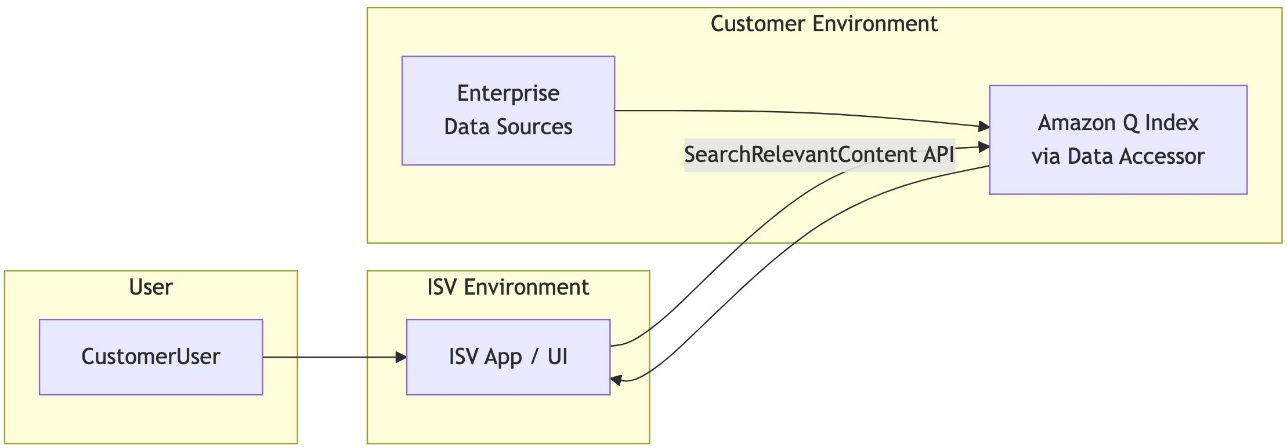Today’s enterprises increasingly rely on AI-driven applications to enhance decision-making, streamline workflows, and deliver improved customer experiences. Achieving these outcomes demands secure, timely, and accurate access to authoritative data—especially when such data resides across diverse repositories and applications within strict enterprise security boundaries.
Interoperable technologies powered by open standards like the Model Context Protocol (MCP) are rapidly emerging. MCP simplifies the process for connecting AI applications and agents to third-party tools and data sources, enabling lightweight, real-time interactions and structured operations with minimal engineering effort. Independent software vendor (ISV) applications can securely query their customers’ Amazon Q index using cross-account access, retrieving only the content each user is authorized to see, such as documents, tickets, chat threads, CRM records, and more. Amazon Q connectors regularly sync and index this data to keep it fresh. Amazon Q index’s hybrid semantic-plus-keyword ranking then helps ISVs deliver context-rich answers without building their own search stack.
As large language models (LLMs) and generative AI become integral to enterprise operations, clearly defined integration patterns between MCP and Amazon Q index become increasingly valuable. ISVs exploring the MCP landscape to automate structured actions such as creating tickets or processing approvals can seamlessly integrate Amazon Q index to retrieve authoritative data. Authoritative data enables accurate and confident execution of these actions, reducing risk, minimizing costly errors, and strengthening trust in AI-driven outcomes. For example, a customer support assistant using MCP can automatically open an urgent ticket and instantly retrieve a relevant troubleshooting guide from Amazon Q index to accelerate incident resolution. AWS continues to invest in tighter interoperability between MCP and Amazon Q index within enterprise AI architectures. In this post, we explore best practices and integration patterns for combining Amazon Q index and MCP, enabling enterprises to build secure, scalable, and actionable AI search-and-retrieval architectures.
Key components overview
Let’s break down the two key components referenced throughout the post: MCP and Amazon Q index.
MCP is an open JSON-RPC standard that lets LLMs invoke external tools and data using structured schemas. Each tool schema defines actions, inputs, outputs, versioning, and access scope, giving developers a consistent interface across enterprise systems. To learn more, refer to the MCP User Guide.
Amazon Q index is a fully managed, cross-account, semantic search service within Amazon Q Business that helps ISVs augment their generative AI chat assistants with customer data. It combines semantic and keyword-based ranking to securely retrieve relevant, user-authorized content through the SearchRelevantContent API, so ISVs can enrich their applications with precise, customer-specific context.
Companies like Zoom and PagerDuty use Amazon Q index to enhance their AI-driven search experiences. For example, Zoom uses Amazon Q index to help users securely and contextually access their enterprise knowledge directly within the Zoom AI Companion interface, enhancing real-time productivity during meetings. Similarly, PagerDuty Advance uses Amazon Q index to surface operational runbooks and incident context during live alerts, dramatically improving incident resolution workflows.
Enhancing MCP workflows with Amazon Q index
To fully capitalize on MCP-driven structured actions, modern AI assistants require enterprise-grade knowledge retrieval capabilities—fast responses, precise relevance ranking, and robust permission enforcement. Effective actions depend on timely, accurate, and secure access to authoritative enterprise data. Amazon Q index directly meets these advanced search needs, providing a secure, scalable retrieval layer that enhances and accelerates MCP workflows:
- Secure ISV integration with the data accessor pattern – ISVs can seamlessly integrate customer enterprise data into their applications using Amazon Q index, providing enriched, generative AI-driven experiences without needing to store or directly index customer data sources. This follows the data accessor pattern, where the ISV acts as a trusted accessor with scoped permissions to securely query the customer’s Amazon Q index and retrieve only authorized results. Companies like Asana, Zoom, and PagerDuty already use this integration approach to enhance their applications securely and efficiently. Highly accurate and managed relevance – Amazon Q index automatically executes both keyword-based (sparse) matching and vector-based (dense/semantic) similarity searches with every SearchRelevantContent API call. Semantic search uses embeddings to understand the contextual meaning of content rather than relying solely on keyword matches, significantly improving accuracy and user satisfaction. Combining semantic and keyword-based search (a hybrid approach) facilitates maximum retrieval accuracy and relevant results. Built-in connectors and automatic indexing – Amazon Q index offers managed, built-in connectors for widely used enterprise applications such as SharePoint, Amazon Simple Storage Service (Amazon S3), and Confluence. These connectors automatically crawl and index enterprise content on a scheduled basis, significantly reducing manual setup and maintenance while keeping data fresh and searchable. Fully managed document-level security – During indexing, Amazon Q index captures source-system ACLs, automatically enforcing these permissions with every query. Users can only search data they’ve been previously granted permission to access. Data is encrypted using customer managed AWS Key Management Service (AWS KMS) keys, with access logged using AWS CloudTrail for auditability.
By managing indexing, ranking, and security, Amazon Q index helps organizations deploy sophisticated enterprise search quickly—typically within weeks. To learn more, see Amazon Q index for independent software vendors (ISVs).
Amazon Q index integration patterns
Now that we’ve explored how Amazon Q index enhances MCP workflows, let’s look at two practical integration patterns enterprises and ISVs commonly adopt to combine these complementary technologies. ISVs and enterprises can access a unified, identity-aware semantic search API called SearchRelevantContent that securely accesses connected enterprise data sources (to learn more, see New capabilities from Amazon Q Business enable ISVs to enhance generative AI experiences).
When planning their integration strategy, organizations typically evaluate factors such as implementation speed, operational complexity, security requirements, and existing MCP commitments. The following patterns highlight common integration approaches, outlining the associated trade-offs and benefits of each scenario:
- Pattern 1 – Amazon Q index integration with a data accessor (no MCP layer) Pattern 2 – Integrating Amazon Q index using MCP tools
Pattern 1: Amazon Q index integration with a data accessor (no MCP layer)
Customers might opt for simplicity and speed by directly using Amazon Q index without involving MCP. The following diagram illustrates this straightforward and fully managed approach.

This pattern is best suited when your primary requirement is direct, performant search through a fully managed API, and you don’t currently need the orchestration and standardization provided by MCP integration. To learn more, refer to Q index workshop and the following GitHub repo.
The pattern includes the following components:
- The
SearchRelevantContent API is called using a secure, scoped AWS Identity and Access Management (IAM) role provided by the ISV. There’s no MCP layer to build, credentials to manage, or infrastructure to run—integration is handled entirely through an AWS managed API. After the ISV-provided IAM role is approved by the enterprise and AWS, AWS manages the backend—including connectors, incremental content crawling, vector and keyword indexing, intelligent ranking, and secure, document-level access control within Amazon Q index. Enterprise permissions are scoped to a single IAM role that the enterprise explicitly approves. Indexed data is encrypted using customer managed KMS keys, with access tightly controlled and fully audited through CloudTrail. Pattern 2: Integrating Amazon Q index using MCP tools
By adding Amazon Q index retrieval using MCP, ISVs maintain a consistent MCP-based architecture across actions and retrieval, as illustrated in the following diagram.

This pattern provides a uniform MCP interface for ISVs who already use MCP tools for multiple structured actions. To learn more, refer to the following GitHub repo.
The pattern includes the following components:
- The
SearchRelevantContent API is wrapped as a tool inside an existing MCP system, adding custom logging or throttling. End-users interact only with the ISV’s application. Behind the scenes, the ISV’s MCP server queries Amazon Q index with the approved data accessor role. ISVs must protect tenant isolation, encrypt transit traffic, and log every call. The enterprise offloads patching and intrusion detection to the ISV but retains document‑level ACL enforcement using Amazon Q index. Considerations for choosing your integration pattern
When choosing your integration pattern, consider these key questions:
- Is rapid deployment with minimal operational overhead your top priority? Choose Pattern 1 (direct
SearchRelevantContent using a data accessor) if you want the fastest route to production-grade, managed retrieval. AWS fully manages indexing, ranking, and document-level permissions, requiring no additional infrastructure from your organization. Are you an ISV aiming to deliver a consistent MCP interface for orchestrating retrieval alongside other tools? Pattern 2 (ISV-hosted MCP) is typically the best choice if you’re an ISV providing a standardized MCP experience to multiple enterprise customers. AWS continues managing indexing, ranking, and permissions, and your organization maintains and operates the MCP server infrastructure for greater orchestration flexibility. Your ideal integration path ultimately depends on balancing rapid deployment, orchestration flexibility, and compliance requirements specific to your organization.
Determining when MCP-only retrieval is sufficient
Although integrating MCP with Amazon Q index effectively addresses most scenarios for enriching ISV application responses with enterprise data, certain clearly defined use cases benefit from a simpler, MCP-only approach. MCP’s schema-driven architecture is ideal for straightforward, keyword-based queries involving a single or limited set of repositories, such as checking ticket statuses. It also excels when real-time data retrieval is essential, including inventory monitoring, streaming log analysis, or accessing real-time metrics, where pre-indexing content offers little value. Additionally, some vendors offer ready-made, MCP-compatible endpoints, such as Atlassian’s interface for Confluence, so enterprises can quickly plug into these MCP servers, access real-time data without indexing, and use secure, feature-rich integrations that are supported and maintained by the vendor.In these scenarios, MCP-only retrieval serves as an efficient, lightweight alternative to fully indexed search solutions like Amazon Q index—especially when the need for orchestration, ranking, and semantic understanding is minimal.
Conclusion
In this post, we explored how ISVs can integrate Amazon Q index into the MCP landscape for enterprise data retrieval, complementing other structured-action tools. Authoritative data is critical for structured actions because it enables accurate decision-making, reduces operational risk, minimizes costly errors, and strengthens trust in AI-driven solutions. By combining MCP’s ability to automate real-time actions with the powerful data retrieval capabilities of Amazon Q index, enterprises and ISVs can rapidly address critical business problems using generative AI. This integrated approach reduces complexity, streamlines operations, and helps organizations meet stringent governance, compliance, and performance standards without the need to build custom indexing and retrieval infrastructure. AWS continues to actively invest in enhancing interoperability between MCP and Amazon Q index. Stay tuned for part two of this blog series, where we explore upcoming integration capabilities and share guidance for building your enterprise AI architectures. To explore Amazon Q index and MCP integrations further, refer to the following resources:
- Guidance for Deploying Model Context Protocol Servers on AWS Amazon Q index for independent software vendors (ISVs)
You can also contact AWS directly or sign in to your AWS Management Console to get started today.
About the authors
 Ebbey Thomas is a Senior Generative AI Specialist Solutions Architect at AWS. He designs and implements generative AI solutions that address specific customer business problems. He is recognized for simplifying complexity and delivering measurable business outcomes for clients. Ebbey holds a BS in Computer Engineering and an MS in Information Systems from Syracuse University.
Ebbey Thomas is a Senior Generative AI Specialist Solutions Architect at AWS. He designs and implements generative AI solutions that address specific customer business problems. He is recognized for simplifying complexity and delivering measurable business outcomes for clients. Ebbey holds a BS in Computer Engineering and an MS in Information Systems from Syracuse University.
 Sonali Sahu is leading the Generative AI Specialist Solutions Architecture team in AWS. She is an author, thought leader, and passionate technologist. Her core area of focus is AI and ML, and she frequently speaks at AI and ML conferences and meetups around the world. She has both breadth and depth of experience in technology and the technology industry, with industry expertise in healthcare, the financial sector, and insurance.
Sonali Sahu is leading the Generative AI Specialist Solutions Architecture team in AWS. She is an author, thought leader, and passionate technologist. Her core area of focus is AI and ML, and she frequently speaks at AI and ML conferences and meetups around the world. She has both breadth and depth of experience in technology and the technology industry, with industry expertise in healthcare, the financial sector, and insurance.
 Vishnu Elangovan is a Worldwide Generative AI Solution Architect with over seven years of experience in Data Engineering and Applied AI/ML. He holds a master’s degree in Data Science and specializes in building scalable artificial intelligence solutions. He loves building and tinkering with scalable AI/ML solutions and considers himself a lifelong learner. Outside his professional pursuits, he enjoys traveling, participating in sports, and exploring new problems to solve.
Vishnu Elangovan is a Worldwide Generative AI Solution Architect with over seven years of experience in Data Engineering and Applied AI/ML. He holds a master’s degree in Data Science and specializes in building scalable artificial intelligence solutions. He loves building and tinkering with scalable AI/ML solutions and considers himself a lifelong learner. Outside his professional pursuits, he enjoys traveling, participating in sports, and exploring new problems to solve.

